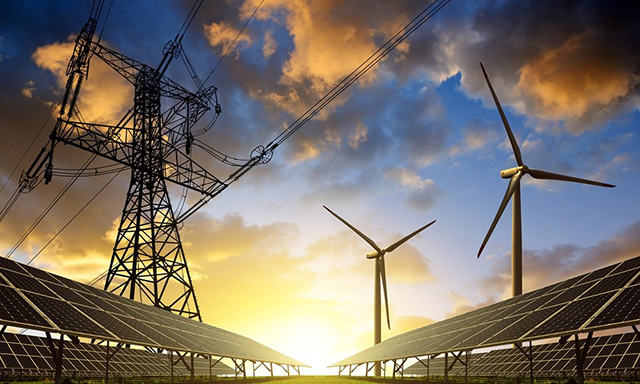
Turkey aims to utilize hydrogen in several energy sector areas including renewables, heating and transportation, according to Turkey’s Energy and Natural Resources Minister Fatih Donmez on Wednesday.
Speaking at a workshop entitled; Scout Meetings in Energy: Hydrogen, organized by the ministry, Donmez described hydrogen as "the energy carrier of the future” and relayed that this element is at the center of current discussions to widen its use in Turkey.
Hydrogen will be part of Turkey’s short and long-term goal to ensure security of energy supply, Donmez said.
In an attempt to decrease the usage of oil, natural gas and other fuels that have a negative impact on the environment and climate, Turkey have boosted efforts to add clean sources to its energy mix, which in turn will also help it become less dependent on imported goods.
One of these efforts published on Dec. 27 was in the introduction of Turkey’s first indigenous automobile prototype - an all-electric vehicle.
The electric car was designed and a prototype manufactured in 18 months by Turkey’s Automobile Joint Venture Group (TOGG), a conglomerate of industrial giants including the Anadolu Group, BMC, Koc Group, Turkcell and Zorlu Holding as well as an umbrella organization, the Union of Chambers and Commodity Exchanges of Turkey.
Hydrogen will have a part to play in these efforts in four different application areas, by putting "indigenousness" at the heart of its energy strategy, Donmez explained.
"These include more incorporation of renewable energy to the system - the decarbonization of the heating sector, hydrogen production from local coal and increasing the use of boron through using hydrogen as a storage and conservation material," he explained.
The minister underlined the importance of producing hydrogen and liquid fuel from coal given the possibility of a reduction in emissions-free transportation costs over the long term.
The natural gas sector has already begun studies to use hydrogen with its first inflow to the distribution system projected to start by the end of 2021 at the latest. However, Donmez noted that this initial step would be an experimental one to test the success of a working system rather than a major start to hydrogen deployment.
Hydrogen is also of major interest to the global transport sector particularly as electric transportation is still a costly option for heavy goods transportation, Donmez said.
"We have an option to provide clean transportation through producing hydrogen from our local coal. Although the costs are currently high [for this option], a bus can travel 1,030 kilometers with hydrogen that is produced from 1 tonnes of coal on top of which it would be without emissions," he said.
After the program, the minister tested a hydrogen-powered car developed by Turkey's Scientific and Technological Research Council (TUBITAK) and Turkey's National Boron Research Institute (BOREN).
Source: AA

The U.S.-based clean technology company Taronis Technologies will establish a facility in Turkey to produce gasification units, the company said in a statement Saturday.
The company offers technology solutions to renewable fuels and sterilization problems by harnessing its proprietary clean gas technology.
Taronis Technologies said 300kW gasification units will be produced in the facility that will be established with an investment of $200 million.
The company in mid-November 2019 announced it launched a Turkish joint venture, Tarronis Fuels Turkey Gas Energy Industry and Trade Limited Company.
The statement also read that the legal process of the Ankara-based venture has also been completed, and all equipment to be used in production will be supplied from Turkey.
"Turkey's strategic location at the heart of Europe, where the continent meets the old Silk Road trade route, provides competitive access to both European and Asian markets," Scott Mahoney, CEO of Taronis Technologies, said in the statement. "This will give Taronis access to productive markets as it seeks to accelerate the sale of more gasification units to neighboring countries and the rise of sustainable fuels worldwide."
Source: Daily Sabah

The EU budget chief said the bloc needs to invest dedicated funds to avert a “climate crash” as Brussels detailed how it planned to pay for a trillion euro push to cut net C02 emissions to zero by 2050 and protect member countries dependent on coal.
The financial challenge for Europe is huge: the European Commission executive arm estimates that halving emissions by 2030 would require 260 billion euros of investment a year in the energy, transport and construction sectors.
“We need climate cash in order to avoid a climate crash,” European Budget Commissioner Johannes Hahn told Reuters on Tuesday.
Of the 1 trillion euros of the EU’s 10-year investment plan, roughly half is to come from the EU long-term budget, the Commission said. This will trigger more than 100 billion in co-financing from governments.
It was unveiling details of its Sustainable Europe Investment Plan using public and private money for its flagship project: the European Green Deal. Some 300 billion would come from private sources and another 100 from the EU’s Just Transition Fund that is to help the EU’s coal-dependent regions, such as Poland’s Silesia mining region, make the transition to “green”. The EU is in the last stretch of talks on the size and spending goals of its next long-term budget from 2021 to 2027. All EU countries except Poland agreed last month they should transform their economies over the next 30 years to not emit more carbon dioxide than they absorb, so as to limit global warming and resulting climate changes.
The deal came amid overwhelming support from Europeans who see irreversible climate change as the biggest challenge they are facing, more so than terrorism, access to healthcare or unemployment. Poland did not subscribe to the 2050 emissions-neutrality goal, arguing its energy systems and economy were too dependent on coal and lignite to make the transition over that time. The Just Transition Fund is to address this problem.
“Yes, I think it will be enough (to convince Poland to join the 2050 climate neutrality goal),” Hahn said.
“It is very attractive because it gives them the opportunity of additional money, access to interesting financing,” he said.
The Fund is to “benefit territories with high employment in coal, lignite, oil shale and peat production, as well as territories with carbon-intensive industries which will be either discontinued or severely impacted by the transition”, the Commission proposal said. The money will go to areas producing the most CO2 industrial emissions, where job losses and the need for teaching new skills and will take into account the overall wealth of the country so that a region in need of transition in the EU’s poorest Romania would get more money than a comparable region in Germany.
The total of 100 billion euros will come from a mix of sources and will mostly be a result of leveraging of 7.5 billion euros of input from the EU budget, EU guarantees and European Investment Bank loans, to attract private cash by covering the riskiest parts of an investment. To increase financing options, the EU will also review its state aid rules by the end of this year, which normally prohibit governments from helping companies in trouble so as not to distort competition.
Governments will be allowed to spend on renewable energy, public charging infrastructure or waste recycling, support workers sacked from closed mines, invest in energy efficiency of buildings, help district heating or climate neutral production processes or the closure of coal-fired power plants. As well as being a huge challenge, the commission sees a switch to an economic model not based on burning fossil fuels for energy as a great opportunity for European industry to shift to making environmentally clean, re-usable and repairable products based on renewable energy sources.
Source: Reuters

A new report by the World Economic Forum says global risk perceptions are shifting. While in previous years economic problems were deemed the biggest threats to mankind, fears of a climate breakdown are now dominating.
In its 15th Global Risks Report published on Wednesday, the World Economic Forum (WEF) has said that for the first time in the report's history all of the "top long-term risks by likelihood" are environmental. While in the previous decade economic and financial crises were seen as most dangerous, the report has found that risk perceptions have shifted to extreme weather, environmental disasters, biodiversity loss, natural catastrophes and failure to mitigate climate change.
"Climate change is a very real and serious threat to society," said Alison Martin, a senior member of Zurich Insurance Group, who helped compile the publication, alongside consultancy Marsh & McLennan and a number of renowned universities from across the world.
"Extreme weather events such as heat waves and flooding are becoming more commonplace and severe, leaving communities to deal with often devastating humanitarian and economic costs," she added.
WEF is an international organization focusing on cooperation between the public and private sectors, and brings together business leaders, government policymakers and representatives of civil society to foster global deliberations on burning issues.
Published in the run-up to the WEF's 50th anniversary meeting in Davos later this month, the report surveyed the opinions of more than 750 global experts and decision-makers to rank their biggest concerns in terms of likelihood and impact. Among the short-term risks facing mankind already in 2020, three out of four respondents to the survey cited economic confrontations, political polarization, extreme heat waves, destruction of natural resource ecosystems and cyberattacks as the most pressing ones.
As the last five years have already been the warmest on record, climate change is expected to strike harder in the coming years, making weather-related disasters more intense and more frequent.
"The near-term impacts of climate change add up to a planetary emergency that will include loss of life, social and geopolitical tensions and negative economic impacts," the report says, adding that failure of climate change mitigation and adaption is the No. 1 risk by impact and number two by likelihood over the next 10 years. With it comes the loss of biodiversity — ranked as the second most impactful and third most likely risk for the next decade — which has critical implications for humanity due to the likely collapse of food and health systems and disruptions of entire supply chains.
Source: DW

As China moves towards a subsidy-free era for wind and solar projects beginning in 2021, the economics of renewable power have come into the spotlight. According to new research China provincial renewables competitiveness report 2019 from Wood Mackenzie Power and Renewables, the average levelised cost of electricity (LCOE) for solar and wind power is already cheaper than gas-fired power in China and will be competitive with coal-fired power by 2026.
In 2019, new-build ultra-supercritical coal plants are the key conventional low-cost power supply option with an LCOE of below $50/MWh, while offshore wind is in the higher range, hitting $116/MWh.
Alex Whitworth, research director with Wood Mackenzie Power and Renewables, said: “Across most of China’s provinces and regions, renewables cost premium remains over coal power, averaging 26% in 2019 for wind and solar, down from over 100% in 2010. 28 of 30 regions examined in our latest report see premiums of up to 70%, and only Shanghai and Qinghai have cost-competitive renewables today.”
This year also marks the first time when solar PV costs have fallen below those of wind power, overturning the latter’s traditional cost advantage. Today, solar PV is cheaper than wind in 19 provinces, including Qinghai, Gansu, Ningxia and Shaanxi. “We’ve seen solar costs drop in China by nearly 40% in the past three years alone, slightly faster than the global average. Technology advancements, government support and expanded scale have contributed to rapidly falling costs,” added Whitworth.
Renewables competitiveness is achievable in the next few years for some of China’s regions, but for others, the journey will not be a sprint but a marathon – taking a decade or more. “Wealthier demand centres on the coast and in parts of central and northeast China will be first to see competitive renewables costs. But renewables investment in some areas of northern China, such as Xinjiang, will not be competitive with coal-fired generation, even by 2040,” commented Whitworth.
Cost competitiveness is not the end of the story. Wind and solar power still only supplied 7.4% of the domestic power generation mix in 2018, compared with 83% from coal and hydropower. The share of renewables is increasing, but the recently announced renewables subsidy phaseout planned for the end of 2020 threatens the profitability of new investments in renewables in coming years. Curtailment is also another key issue to deal with in China and creates uncertainty in LCOE modelling in the medium to long term. A 1% rise in curtailment typically increases the costs of wind or solar plants by 1.2%.
The costs of solar-plus-storage and offshore wind are expected to decline much faster than conventional fuels in the outlook. By 2040, solar-plus-storage costs will range between $33-85/MWh due to declines in battery costs and economies of scale. “Offshore will be a key technology for increasing renewables penetration near coastal demand centres. Technology improvement, economies of scale and a high capacity factor are driving costs down. Annual cost declines of 6% will make offshore wind competitive with gas by about 2025 and coal by 2032,” added Whitworth.
Source: Smart Energy International

Renewable sources currently supply 26 per cent of global power, but this share needs to more than double by 2030 to ensure climate safety and sustainable development, officials from the International Renewable Energy Agency (Irena) announced in the capital on Sunday.
In fact, at least 57 per cent of global power must be derived from renewable sources like solar, wind, geothermal and biofuel by 2030, and this will require annual investment in the sector to double from $330 billion (Dh1,212 billion) to $750 billion (Dh2,754 billion).
“When we talk about investment, we mean private investment,” clarified Francesco La Camera, Irena director general.
He was speaking on the second day of the 10th Irena general assembly. The Assembly itself kicked off Abu Dhabi Sustainability Week, the leading regional event aimed at supporting and promoting a global energy transformation.
“We have entered the decade of renewable energy action, a period in which the energy system will transform at unparalleled speed. To ensure this happens, we must urgently address the need for stronger enabling policies and a significant increase in investment over the next 10 years,” La Camera said.
The official also called for a change in attitude towards renewables, which he said were the key to sustainable development because of their affordability, availability and scalability. He mentioned that there is still a focus on fossil fuels in some countries, but that the energy mix will be entirely different in 20 to 30 years.
“We have to appeal to energy companies to diversify their portfolios by looking into renewables. In fact, companies working with gas [could be instrumental] as thy already have the hydrogen pipeline infrastructure,” La Camera said.
Falling technology costs are strengthening the case for renewables as well, with solar photovoltaic costs having decreased by almost 90 per cent over the last decade, and onshore wind prices having halved over the same period. The Irena estimates that the prices of the two technologies could outcompete prices of traditional energy sources by the end of the decade, and that the two sources could cover over a third of global power needs. In additional, renewable sources are especially effective at ensuring off-grid energy access, with 150 million people worldwide relying on renewable off-grid power.
Source: Gulf News
The Future of the Last-Mile Ecosystem
Growing demand for e-commerce delivery will result in 36% more delivery vehicles in inner cities by 2030, leading to a rise in both emissions and traffic congestion without effective intervention. Without effective intervention, urban last-mile delivery emissions and traffic congestion are on track to increase by over 30% in the top 100 cities globally. The Future of the Last-Mile Ecosystem analyses 24 interventions that can reduce emissions, congestion and delivery costs for the urban last-mile. With the ecosystem-wide change, interventions could reduce emissions and traffic congestion by 30%, and delivery cost by 25%, compared to the “do-nothing” scenario.
Please click here to read the full report.
Solar Istanbul 2020
March 11 - 13 / Istanbul
3rd International Forum Energy for Smart Mobility
March 31 - April 01 / Marseille
InnoGrid2020+ Conference
May 05 - 06 / Brussels
23rd World Hydrogen Energy Conference
July 05 - 09 / Istanbul
4th International Conference on Energy Research and Technology
August 19 - 21 / Praque

